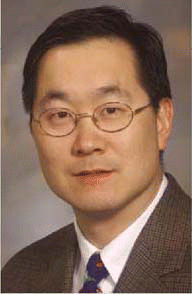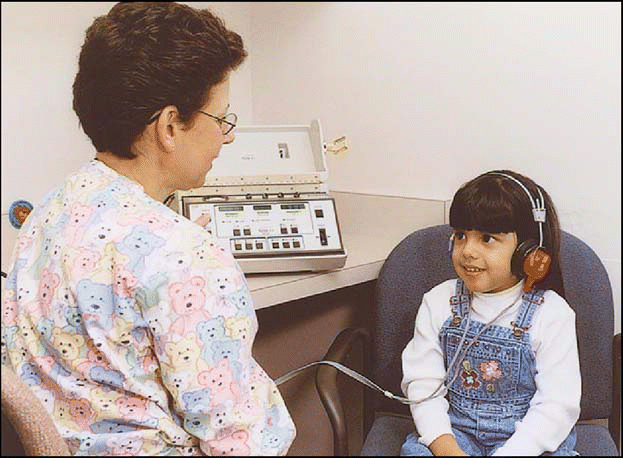Approximately 28 million people living in the United States suffer from some degree of hearing loss. It is the most frequently occurring birth defect—about three of every 1,000 babies are born with hearing loss. Years of research indicate that prompt diagnosis and treatment of hearing loss is key in helping these individuals to function with little or no handicap. Because of vast improvement in technology and screening programs, the goal of early diagnosis and treatment of hearing loss is now within our reach.
Explore This Issue
September 2009In 1988 the Commission on Education of the Deaf reported to Congress that the average age at which children with congenital hearing loss were identified was 2½ to 3 years, and in many cases, not until 5 or 6 years. This delay in identifying—and treating—hearing loss in children makes it difficult or impossible for these children to develop fundamental language, social, and cognitive skills. Research has shown that children who receive early intervention and amplification (before 6 months vs after 6 months of age) are one to two years ahead of their later-identified peers in language, cognitive, and social skills by the time they enter first grade. For this reason, the National Institutes of Health’s (NIH) consensus Development Conference on Early Identification of Hearing Loss in 1993 concluded that all infants should be screened for hearing impairment, preferably prior to discharge from the hospital.
“Children with middle ear fluid often undergo multiple screening tests, a big cost for all of us to have to incur. Often, if we can medically or surgically treat that fluid, the loss may resolve. Otolaryngologists are in the best position to pick up on that and render the appropriate treatment.” – —Albert H. Park, MD
To this end, the Centers for Disease Control and Prevention (CDC) has developed the Earlier Hearing Detection and Intervention Program (EHDI). This program has several goals, including:
- Early screening (initial testing).
- Audiologic evaluation (to confirm hearing loss).
Early intervention (including medical treatment, early intervention services, and support) to enhance communication, thinking, and behavioral skills needed to achieve academic and social success.
This program recommends that all newborns be screened for hearing loss before 1 month of age, preferably before discharge from the hospital. It further advises that all infants who fail the initial screening should have a diagnostic audiologic evaluation before 3 months of age, and all infants identified with a hearing loss should receive appropriate intervention before 6 months of age.
Early Detection
In 1988, then-Surgeon General C. Everett Koop, MD, set a goal that all children with significant hearing loss would be identified before 12 months of age. Given the techniques available for infant hearing screening at that time, and the fact that the average age of identification was 2½ to 3 years, this seemed unrealistic. Since then, improved techniques and procedures have made it possible to conduct hearing screening at younger ages, so that it is now a realistic goal to screen every newborn in the United States for hearing loss.
Conducting hospital-based universal newborn hearing screening costs between $10 and $50 per baby, depending on the technology and program used. This is about one-tenth the cost per child identified with phenylketonuria (PKU), hypothyroidism, or sickle-cell anemia in metabolic disorder screening programs, which are required in all 50 states. This cost can be offset many times over by the estimated $400,000 per child that can be saved in special education costs if the child is identified early and receives appropriate intervention and education.
According to the CDC website, there are currently 37 states that have some form of legislation enacted relating to EHDI, and approximately 2,500 universal newborn screening programs. However, according to the National Center for Hearing and Assessment Management Fact Sheet, some estimate that still only about 35% of the babies born in the United States are born in hospitals with universal newborn hearing screening programs. This remains a vast improvement, however, over the number of infant screenings that were done a decade ago.
Follow-Up
Despite the growing success of the early screening program, there is still much work to be done to ensure that infants identified with possible hearing loss receive the appropriate follow-up testing. A study published in Otolaryngology–Head and Neck Surgery in May reported the results of a survey of parental views regarding their child’s hearing loss. Fourteen percent of the parents responding to this survey reported that they did not even know the results of their newborn’s hearing screening. More than 15% of the families noted that no one provided information for additional testing.
Another article, “Hearing Screening at Well-Child Visits,” published in the Archives of Pediatric and Adolescent Medicine in October 2005, concluded that more than half (59%) of the children involved in the study who failed hearing screening by their pediatricians were never rechecked or referred for further testing. Surprisingly, even children with known risk factors for progressive hearing loss had no further action taken following a failed screening.
The reasons that pediatricians did not refer or recheck children who failed the initial screening were not obtained in the Archives of Pediatric and Adolescent Medicine study, either prospectively or retrospectively, in an effort to avoid altering the physicians’ plan of action. However, in the Otolaryngology–Head and Neck Surgery article, the primary reasons for delay in diagnosis, from the parents’ perspectives, included:
- Difficulty in obtaining an appointment for additional testing.
- Delay from trying to obtain a referral from the primary care physician.
- Multiple screening or diagnostic tests.
- Poor medical advice.
This study indicates that parents feel at somewhat of a loss as to how to best proceed in being an advocate for their child regarding hearing screening. They identified a need for early counseling of families early in the screening process and a greater emphasis on primary care involvement and education.
The Otolaryngologist’s Role
Albert H. Park, MD, of the University of Utah School of Medicine, Division of Otolaryngology–Head and Neck Surgery, and primary author of the Otolaryngology–Head and Neck Surgery study, feels that otolaryngologists should be more involved in pediatric hearing screening earlier on in the process. He stresses that a failed screening does not necessarily indicate a hearing loss. The most common reason for initial failure of a screening is middle ear fluid, according to Dr. Park. He says that an otolaryngologist is best equipped with the necessary training and expertise necessary to differentiate between a failed screening due to middle ear fluid—or excessive wax buildup—rather than actual hearing loss. Dr. Park states, “Children with middle ear fluid often undergo multiple screening tests, a big cost for all of us to have to incur. Often, if we can medically or surgically treat that fluid, the loss may resolve. Otolaryngologists are in the best position to pick up on that and render the appropriate treatment.”
Medical Staff and Parental Education
With 14% of parents reporting that they were not aware that their child had failed initial screening, and 15% reporting they received no information regarding follow-up, the parental survey published in Otolaryngology–Head and Neck Surgery clearly indicates that there is a need for better education of hospital personnel and primary care physicians and staff regarding the implications of a failed hearing screening and appropriate follow-up.
Dr. Park advocates a multidisciplinary approach, including social workers and individuals familiar with resources available to families, both with regard to testing and with financial options for those children requiring interventions. He states that it is very important that the primary care physician or pediatrician maintain an active role in the screening and treatment of hearing loss, providing the recommended “medical home.” This team approach can help better equip parents with the knowledge and direction to be effective advocates for their children.
The advantages of earlier diagnosis and treatment of hearing loss are clearly documented. Although early screening programs have become much more prevalent in recent years, screenings that do not result in follow-up and intervention are a waste of resources and offer no definitive advantage to the infants and children being screened.
The opportunity exists to offer much more comprehensive screening and follow-up programs. Otolaryngologists can assist in this effort by taking a more active and early role in hearing screening programs and follow-up and by offering their unique experience and expertise. As Dr. Park concludes, “My opinion is that we as a specialty haven’t been that aggressive or as involved as we need to be.”
The National Center for Hearing Assessment and Management has a resource guide available, “Implementing Universal Newborn Hearing Screening Programs,” by Karl White, PhD, and Antonia Brancia Maxon, PhD (available at www.infanthearing.org ), which offers excellent guidance in creating a screening program. However, as stated in the guide, “The real goal of any screening program is to provide better health care services to people in need. Consequently, newborn hearing screening is only the first step.”
©2006 The Triological Society


Leave a Reply